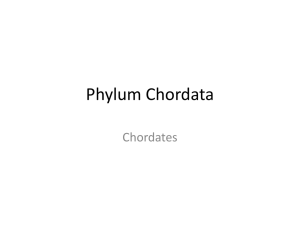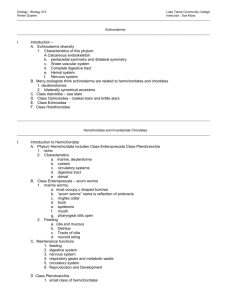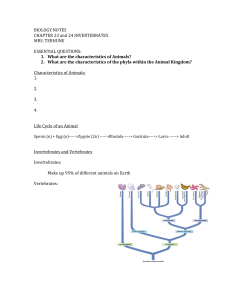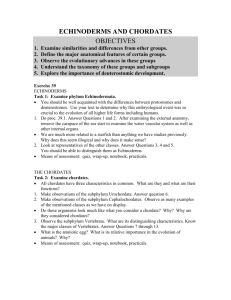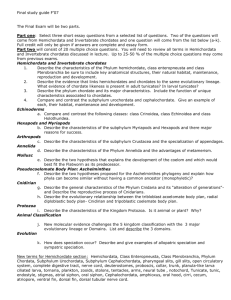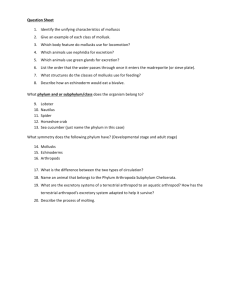· BIOMEDICAL SCIENCES 108
advertisement
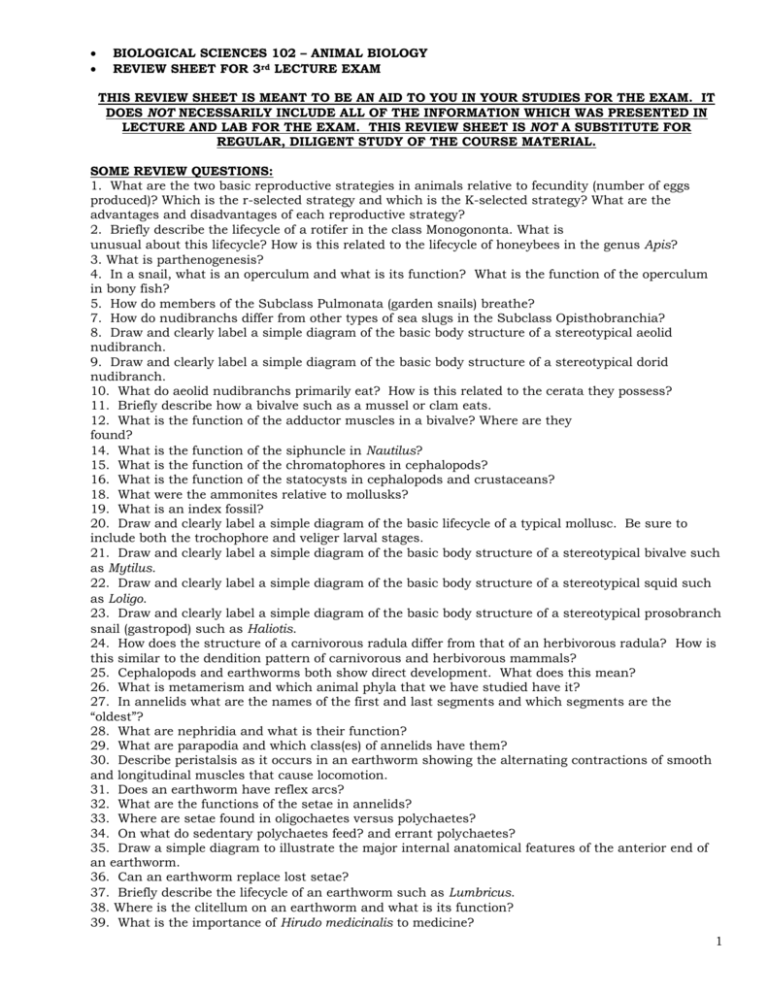
BIOLOGICAL SCIENCES 102 – ANIMAL BIOLOGY REVIEW SHEET FOR 3rd LECTURE EXAM THIS REVIEW SHEET IS MEANT TO BE AN AID TO YOU IN YOUR STUDIES FOR THE EXAM. IT DOES NOT NECESSARILY INCLUDE ALL OF THE INFORMATION WHICH WAS PRESENTED IN LECTURE AND LAB FOR THE EXAM. THIS REVIEW SHEET IS NOT A SUBSTITUTE FOR REGULAR, DILIGENT STUDY OF THE COURSE MATERIAL. SOME REVIEW QUESTIONS: 1. What are the two basic reproductive strategies in animals relative to fecundity (number of eggs produced)? Which is the r-selected strategy and which is the K-selected strategy? What are the advantages and disadvantages of each reproductive strategy? 2. Briefly describe the lifecycle of a rotifer in the class Monogononta. What is unusual about this lifecycle? How is this related to the lifecycle of honeybees in the genus Apis? 3. What is parthenogenesis? 4. In a snail, what is an operculum and what is its function? What is the function of the operculum in bony fish? 5. How do members of the Subclass Pulmonata (garden snails) breathe? 7. How do nudibranchs differ from other types of sea slugs in the Subclass Opisthobranchia? 8. Draw and clearly label a simple diagram of the basic body structure of a stereotypical aeolid nudibranch. 9. Draw and clearly label a simple diagram of the basic body structure of a stereotypical dorid nudibranch. 10. What do aeolid nudibranchs primarily eat? How is this related to the cerata they possess? 11. Briefly describe how a bivalve such as a mussel or clam eats. 12. What is the function of the adductor muscles in a bivalve? Where are they found? 14. What is the function of the siphuncle in Nautilus? 15. What is the function of the chromatophores in cephalopods? 16. What is the function of the statocysts in cephalopods and crustaceans? 18. What were the ammonites relative to mollusks? 19. What is an index fossil? 20. Draw and clearly label a simple diagram of the basic lifecycle of a typical mollusc. Be sure to include both the trochophore and veliger larval stages. 21. Draw and clearly label a simple diagram of the basic body structure of a stereotypical bivalve such as Mytilus. 22. Draw and clearly label a simple diagram of the basic body structure of a stereotypical squid such as Loligo. 23. Draw and clearly label a simple diagram of the basic body structure of a stereotypical prosobranch snail (gastropod) such as Haliotis. 24. How does the structure of a carnivorous radula differ from that of an herbivorous radula? How is this similar to the dendition pattern of carnivorous and herbivorous mammals? 25. Cephalopods and earthworms both show direct development. What does this mean? 26. What is metamerism and which animal phyla that we have studied have it? 27. In annelids what are the names of the first and last segments and which segments are the “oldest”? 28. What are nephridia and what is their function? 29. What are parapodia and which class(es) of annelids have them? 30. Describe peristalsis as it occurs in an earthworm showing the alternating contractions of smooth and longitudinal muscles that cause locomotion. 31. Does an earthworm have reflex arcs? 32. What are the functions of the setae in annelids? 33. Where are setae found in oligochaetes versus polychaetes? 34. On what do sedentary polychaetes feed? and errant polychaetes? 35. Draw a simple diagram to illustrate the major internal anatomical features of the anterior end of an earthworm. 36. Can an earthworm replace lost setae? 37. Briefly describe the lifecycle of an earthworm such as Lumbricus. 38. Where is the clitellum on an earthworm and what is its function? 39. What is the importance of Hirudo medicinalis to medicine? 1 40. How many segments does a leech possess? 41. Draw a simple diagram to describe the most basic parts of a generalized single circuit closed 42. circulatory system. 43. How does a closed circulatory system differ from an open one? 44. Draw a simple diagram to describe the most basic parts of a generalized two circuit closed circulatory system with pulmonary and systemic circuits. 45. In terms of basic physics, what is color? 46. Give 5 different specific examples where color plays an important role in the life history of animals. 47. What is the wavelength and frequency of a wave? 48. Draw and clearly label a diagram of the carbon cycle showing the flow of carbon in both the terrestrial and aquatic/marine ecosystems. 49. Draw and clearly label a diagram of the nitrogen cycle showing the flow of nitrogen in both the terrestrial and aquatic/marine ecosystems. 50. Draw and clearly label a diagram of the water cycle. 51. Know the basic body plan characteristics of the following animal phyla and subphyla: Subphylum Chelicerata, Subphylum Crustacea, Subphylum Uniramia, Phylum Echinodermata, Phylum Chordata. 52. Draw and clearly label a simple diagram of the basic body structure of a stereotypical trilobite. 53. Draw and clearly label a simple diagram of the basic body structure of a stereotypical spider. 54. Draw and clearly label a simple diagram of the basic body structure of a stereotypical scorpion. 55. Draw and clearly label a simple diagram of the basic body structure of a stereotypical tick. 56. Draw and clearly label a simple diagram of the basic body structure of a stereotypical decapod. 57. Draw and clearly label a simple diagram of the basic body structure of a stereotypical centipede. 58. Draw and clearly label a simple diagram of the basic body structure of a stereotypical millipede. 59. Draw and clearly label a simple diagram of the basic body structure of a stereotypical insect. 60. Draw and clearly label a simple diagram of the basic body structure of a stereotypical sea star. 61. Draw and clearly label a simple diagram of the basic body structure of a stereotypical sea urchin. 62. Draw and clearly label a simple diagram of the basic body structure of a stereotypical lancelet such as Branchiostoma. 63. Draw and clearly label a simple diagram of the basic body structure of a stereotypical tunicate such as Molgula.. 64. Draw and clearly label a simple diagram of the basic body structure of a stereotypical cartilaginous fish such as a shark. 65. Draw and clearly label a simple diagram of the basic body structure of a stereotypical bony fish. 66. Describe the basic structure of the exoskeleton of an arthropod 67. Describe the molecular structure of chitin 68. What is a hormone? 69. What is a pheromone? 70. Give three examples of how pheromones regulate animal physiology or behavior. 71. How does an open circulatory system differ from a closed circulatory system? 72. List the 4 major types of respiratory structures found in animals 73. List three major differences between members of the phylum Arthropoda and the phylum Annelida. 74. How does a harvestman or “daddy longlegs” differ from members of the order Aranae? 75. To what class and order do ticks and mites belong? 76. What causes Lyme disease? What animal carries Lyme disease? Why is this condition called 77. List the function of each of the following appendages in a crustacean (see text page 390): first & second antennae, mandible, first maxilla, second maxilla, first, second and third maxillipeds, cheliped, walking legs, first swimmeret, second through fifth swimmerets, uropod. 78. What is the function of the green gland in crustaceans? 79. What are the parts of a crustacean stomach? Which chamber has “teeth”? 80. In crustacean, what is a gastrolith and what is its function? 81. How does an isopod differ in its basic body plan from a copepod? 82. How does a member of the class Chilopoda differ from a member of the class Diplopoda? 83. How many pairs of antennae are found in members of each of the three subphyla of the 84. Why are members of the order Hemiptera called “true bugs”? 85. Describe the caste system and basic social organization in a honeybee hive. What are the specific castes? 86. How does a honeybee hive form a new queen if the queen dies or leaves? 87. What make the worker bees in a honeybee hive functionally sterile? 88. What is the evolutionary benefit of the caste system in social insects? 2 89. How do honeybees and other insects find their food/flower nectar? 90. How does incomplete metamorphosis differ from complete metamorphosis in insects? 91. Describe how the direct and indirect flight muscles in an insect operate to allow insects to fly. 92. Which orders of insect use indirect flight muscles? 93. Describe the basic process of ecdysis as it occurs in crustaceans and insects. What happens when a crustacean or insect molts. Describe changes in the various layers of the exoskeleton. 94. Describe the hormone control of ecdysis in crustaceans. What organs and specific hormones are involved? 95. Describe the hormone control of ecdysis in insects. What organs and specific hormones are involved? 96. What are the 5 major body plan characteristics of the Phylum Chordata? 97. How do the following classes in the phylum Echinodermata basically differ? Class Crinoidea Class Asteroidea Class Ophiuroidea Class Echinoidea Class Holothruoidea 98. Basically, how do the following taxa in the phylum Arthropoda differ? Subphylum Trilobita Subphylum Chelicerata Class Pycnogonia Class Arachnida Order Aranae Order Scorpiones Order Opiliones Order Acari Subphylum Crustacea Class Branchipoda Class Maxillopoda Class or Subclass Copepoda Class or Subclass Cirripedia Class Malacostraca Order Isopoda Order Amphipoda Order Euphausiacea Order Decapoda Subphylum Uniramia Class Chilopoda Class Diplopoda Class Insecta Subclass Apterygota Order Thysanura Subclass Pterygota Infraclass Paleoptera Order Ephemeroptera Order Odonata Infraclass Neoptera Order Orthoptera Order Plecoptera Order Isoptera Order Mallophaga Order Anoplura Order Hemiptera Order Homoptera Order Neuroptera Order Colegoptera Order Lepidoptera Order Diptera Order Siphoanptera Order Hymenoptera 3 99. Be aware of the definitions and importance of the following terms: Phylum Arthropoda: Subphylum Chelicerata tagmata cuticle procuticle epicuticle exocuticle endocuticle molting ecdysis tracheal tubes book lungs metamorphosis carapace telson prosoma opisthosoma chelicerae fangs pedipalps walking legs Malpighian tubules simple eyes silk glands pectines 100. Be aware of the definitions and importance of the following terms: Phylum Arthropoda: Subphylum Crustacea mandibulate antennae antennule cephalothorax abdomen biramous appendage rostrum uropod carapace telson gills tergum sternum hemocoel green glands supraesophageal ganglia statocysts ommatidia molt-inhibiting hormone (MIH) X organ molting hormone (ecdysone) Y organs 101. Be aware of the definitions and importance of the following terms: Phylum Arthropoda: Subphylum Uniramia head prothorax mesothorax metathorax abdomen ovipositor cercus coxa trochanter femur tibia tarsus antenna cleaner halteres direct flight muscles indirect flight muscles phytophagous saprophagous sucking mouthparts sponging or lapping mouthparts chewing mouthparts tracheal tubes/system sensilla compound eye holometabolous (complete) metamorphosis hemimetabolous (incomplete) metamorphosis larva pupa (chrysalis) nymph instar diapause mimicry 102. Be aware of the definitions and importance of the following terms: Phylum Echinodermata water vascular system dermal endoskeleton pentaradial symmetry ambulacral grooves pedicellariae tube feet 4 madreporite hemal system dermal branchiae bilateral larvae stone canal ring canal radial canals ampullae of tube feet pyloric ceca (digestive glands) pyloric stomach cardiac stomach Aristotle’s lantern 103. What type of symmetry is found in most larval echinoderms? What type of symmetry is found in most adult echinoderms? What is meant by pentaradial symmetry? 104. What is the function of the pedicellariae in echinoderms? In what portion of the marine environment do echinoderms live? How might a pentaradial symmetry body benefit them? 105. Where is and what is the function of Aristotle’s Lantern in a sea urchin? 106. Briefly describe the structure and function of the water vascular system in an echinoderm. 107. Describe and/or draw and clearly label a diagram to show the digestive system of a sea star. 108. Briefly describe what happens when a sea star eats a bivalve. 109. Can the spines on a sea urchin move? How? 110. Are most echinoderms diecious or monoecious? Is their fertilization external or internal? 111. Do sea stars have eyes or other photorepectors? Do they possess statocysts? Do they have tactile/mechanoreceptors? 112. How do sea stars get oxygen into their cells from the surrounding seawater? 113. Briefly describe the basic lifecycle of a sea star and a sea urchin. 114. What are the main anatomical differences between brittle stars in the Class Ophiuroidea from sea stars in the Class Asteroidea. 115. How does the body plan and what characteristics of a sea cucumber in the Class Holothruoidea make sea cucumbers different from other echinoderms? 116. To which class do sand dollars belong? 117. Do echinoderms have a circulatory system? Do echinoderms have an excretory system? What is a notochord? 118. What is a cephalochordate? Provide a description of the characteristics of this taxa. To what subphylum do these organisms belong? 119. What is a urochordate? Provide a description of the characteristics of this taxa. To basically duplicate this table. 120. Are all vertebrates chordates? Are all chordates vertebrates? 121. What is a cranium? 122. How does a member of the Superclass Agnatha differ from a member of the Superclass Gnathostomata? 123. How does a member of the Class Actinopterygii differ from a member of the Class Chondrichthyes? 124. How does a member of the Class Sarcopterygii differ from a member of the Class Actinopterygii? 125. Provide some very basic characteristics that differentiate the following class from any class of fish: Class Amphibia Class Reptilia Class Aves Class Mammalia 126. What is an ostrcaderm fish? 127. What is a placoderm fish? 128. During what geologic periods did the placoderm and ostracderm fishes radiate and dominate the aquatic habitats on earth? 129. How does a ray-finned fish differ from a lobe finned fish? 130. What is a coelacanth? Are there still living members of this group found today? Where? 131. How does a member of the Class Myxini differ from a member of the Class Cephalaspidomorphi? (what are some body characteristics that differ between these animals?) 132. To what subclass within the subphylum vertebrata do sharks, skates and & rays belong? 133. How does a cartiliaginous skeleton differ from a bony skeleton with regard to its molecular/cellular structure? 134. What is the function of a chondroblast cell? 135. What is the function of an osteoblast cell? 136. What is the function of an osteoclast cell? 5 137. How does a heterocercal, homocercal, and diphycercal tail differ? In what groups of fishes are each of these caudal fins types found? 138. Describe the basic structure of vertebrate integument (skin)? How does each layer differ in its position and other organ structures found in each? 139. Describe the basic structure of a placoid, ganoid, cycloid and ctenoid scale. 140. In what fish groups are each of the above scale types found? 141. Where is and what is the function of the spiral valve in sharks? 142. How many sets of teeth do sharks develop on average? How are shark teethed replaced when lost? (all at once?) 143. What is the organ (ampullae) of Lorenzini in a shark? 144. What is a cloaca? 145. Do sharks generally have internal or external fertilization? 146. How do oviparous, ovoviviparous, or viviparous animals differ? 147. To what class does the California Torpedo Ray belong? What is one way this animal can defend itself? 148. Regarding fishes, what is an operculum and what is its function? Which fish groups have one? 149. Which part of a sharks skeleton can be ossified/bony? 150. What is a teleost fish? Give one characteristic of this fish that is different from other fish. 151. What is meant by neutral buoyancy? How do sharks maintain neutral buoyancy? (two features involved here) Why do most sharks constantly need to swim at least slowly? Why can some sharks stop swimming? What is the function of the spiracles in a shark? 151. Which groups of fish possess a swim/air bladder? 152. What is the function of a swim bladder in a fish? What is the rete mirable? How does air enter and leave the swim bladder? 153. Draw a simple timeline to show when each of the following events occurred in the history of life on Earth: (general time frame/general periods) radiation of the modern animal phyla (what and when was the “explosion”) early colonization of land by arthropods evolution of first jawed fishes diversification of the bony fishes evolution of first amphibians extensive forests of vascular plants/first seed plants radiation of most modern insect orders gymnosperms plants dominate and radiation of dinosaurs angiosperms appear and dinosaurs go extinct major radiation of birds, mammals and pollinating insects origin of many primate groups ape-like ancestors of humans (Australopithecines) evolution of modern man/first humans (Homo sapiens) 154. Define the term: speciation. What is a species? 155. What is the Hardy-Weinberg Equation? 156. What is the Hardy-Weinberg Equilibrium? What does this mean? 157. What is adaptive radiation? 158. Do larger or smaller populations tend to evolve faster? Why? 159. List and briefly describe four pre-zygotic (before fertilization) reproductive barriers and two postzygotic (after fertilization) reproductive barriers between species. 160. Hardy, Weinberg, and the population geneticists who followed them came to understand that evolution will not occur in a population if seven conditions are met. List at least 5 of these condtions. 161. Define the following terms and relate how they could change the genetics of a population and lead to the evolution of new species from a common ancestor: Mutation Gene Flow Genetic Drift Bottleneck Effect 6 Founder Effect Natural Selection 7

